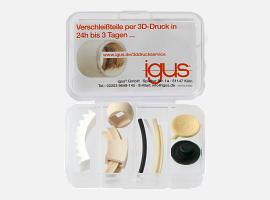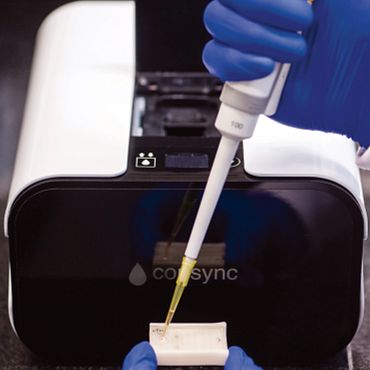3D printing materials

▶️ To the material shop
You don't have a 3D printer and would like igus® to print wear-resistant components for you?
In our online 3D printing service, you can easily upload a CAD file and even calculate the service life for your part. We will manufacture your individual components or series from our in-house materials. Your order will be ready for delivery in one to three days!
▶️ To the 3D printing service

Our 3D printing processes and materials
3D printing process at igus®
To fulfil the wide range of requirements of our business partners, our 3D printing service offers three different processes:- Selective laser sintering (SLS)
- Fused Deposition Modelling (FDM)
- Digital Light Processing (DLP)
Specifications of the igus® 3D printing materials
Wherever components come into contact with each other through movement, igus materials are the ideal solution.Our SLS powders, tribofilaments and DLP resins are suitable for a wide range of applications.
From food conformity and ESD specifications to chemical and heat resistance.
Real-life applications
All our business partners want 3D-printed components to be lubrication-free and maintenance-free. Other application-specific requirements are also fulfilled by the 3D printing service from igus®.Our new 3D printing products
Discover our latest product innovations! Here you can find out everything about newly developed materials and digital services for additive manufacturing with wear-resistant plastics.
3D Printing Wiki: technical information about 3D printing
- Frequently asked questions about the specifications and processing of our 3D printing materials
- Design instructions and printing tips for industrial 3D printing
- Free downloads of topic-specific e-papers
- Recordings of past webinars and dates for future live streams
Frequently asked questions
What plastic is used in 3d printing?
There is a range of traditional plastics that can be used for 3D printing such as PLA, ABS and PVA. At igus®, we have our own range of filaments and laser sintering materials. This allows customers to be able to print custom parts with high wear-resistant materials with good mechanical properties.
On which 3D printers can the iglidur® laser sintering powders be processed?
igus® uses the EOS Formiga P110. In principle, the tribo-materials iglidur® I3-PL and iglidur® I6-PL should be able to be processed on laser sintering 3D printers with CO2 lasers, if the printing parameters can be adjusted. Due to the different absorption of the laser energy, it is not suitable for low-cost systems such as Sinterit Lisa or Formlabs Fuse 1. The iglidur® I8-ESD-PL is suitable for this due to its black colour.
Which laser sintering material is best suited for gears?
iglidur® I3 has the longest service life of all igus® 3D printing materials in tests with spur gears. For worm gears, iglidur® I6 is better suited due to the sliding relative movement between the counter partners.
Which filament 3D printer does igus® recommend?
Due to the large number of systems available on the market, no clear recommendation can be made. Basically, the printer should have a sufficiently large and closed installation space as well as a heated print bed. In addition, a print head with two nozzles, or two independent print heads that can heat up to 300°C, is recommended. The device should also be freely configurable, i.e. the processing parameters should be adjustable and it should be possible to process filaments from third-party manufacturers. You should be able to process our filaments on most common printers without any problems.
Free material sample box

Convince yourself of our materials and order a box with material samples and printed examples from our additive manufacturing.
Design guide for additive manufacturing
Our Design Guide provides you with practical tips on designing functional parts for manufacture in the 3D printing service.



